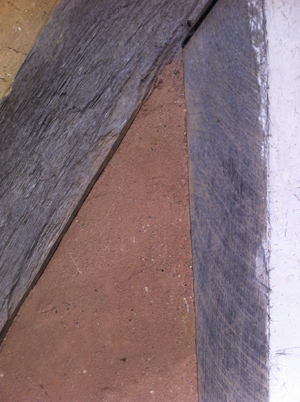Subscribe
to Orchard Barn's mailing list and receive
all
the latest offers on courses, volunteer tips and highlights and my
BLOGS
about the project ....
AND you'll be entered for a competition
to win a one
day course at Orchard Barn.
Get lucky.
Choose from the
Natural Building Experience, A Day in the Woods, Deadwood Screens,
Wattle and Daub, Intro to using Lime, Clay Selfies, Greenwood in
Building, Off-grid Compost Toilets ...

|
|
Getting
Plastered 16th February 2019
I am
frequently asked 'How did
all this begin?' I have many
answers to this question, depending on who’s doing the asking. They
range from ‘it’s
in my blood’ to ‘couldn’t help myself’, both of which are completely
true.
I was
born in a medieval timber frame house. Timber frames
were my mum’s passion. She was a Local Recorder. No great surprise then
that my
very first renovation project was a two up, two down 17th century
timber frame
cottage. It had been empty for twenty two years and was a bit down on
its luck
(understatement). I was just nineteen but Practical.
Long
story, but we took the roof off, floors up, piped
potable water over a mile, installed a septic tank and some new-fangled
connections by way of electricity and telephone! We put windows in,
found a
giant inglenook and finally, two adventurous years later we were ready
for the
final finishes.
It was
at that stage I taught myself to plaster. Not yummy
palatable lime or the slow build earth render that I would use now, but
something that I won’t name suffice to say it was pink and came in a
packet. Oh,
and it set very quickly.
Due to
my inexperience I started in the kitchen and worked
my way round the tiny house. Now if you come to undertake such a
project please
learn from my mistake. To say that the final finish in the kitchen was
‘rustic’
is an understatement. However, by the time I had reached the back of
the
cupboards upstairs, you’ve guessed it, I was proficient in plaster
management
and the walls were perfectly slippy smooth. And the moral of my story
is ..... to start
somewhere that isn’t going to be readily seen, practice, practice,
practice. I'm not saying you won't get plastered on the way, but little
by little more stays on the wall and ceilings and there are less
adornments to hair and clothes.
Photo on
left shows daub panel in between timber frame. I'll write more about
plastering with mud and brick dust next time! Interested in learning
about building with materials from the local landscape? Book yourself onto my Natural Building Experience and learn from the mistakes I've made in my 40 year career with mud, sticks and timber frames.
|
|